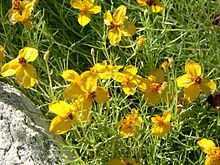Zinnia grandiflora
| Zinnia grandiflora | |
|---|---|
 | |
| Scientific classification | |
| Kingdom: | Plantae |
| (unranked): | Angiosperms |
| (unranked): | Eudicots |
| (unranked): | Asterids |
| Order: | Asterales |
| Family: | Asteraceae |
| Tribe: | Heliantheae |
| Genus: | Zinnia |
| Species: | Z. grandiflora |
| Binomial name | |
| Zinnia grandiflora Nutt. | |
Zinnia grandiflora is a species of flowering plant in the aster family known by the common names Rocky Mountains zinnia and Plains zinnia. It is native to the southwestern and south-central United States and the northern states of Mexico, where it grows on plains and foothills and other dry habitat.
It is a subshrub growing up to 22 centimeters tall with many slender, branching stems. The oppositely arranged leaves are linear in shape and measure 1 to 3 centimeters long. The herbage is covered in short, rough hairs. The flower head has 3 to 6 bright yellow ray florets each between 1 and 2 centimeters in length. At the center is a cluster of several tubular disc florets.
Uses
This plant is used by several Native American groups, including the Zuni and Navajo, for medicinal and ceremonial purposes.[1]
Among the Zuni people, this plant is applied in a poultice to bruises, cold infusion of blossoms used as an eyewash, and smoke from powdered plant inhaled in sweatbath for fever.[2]
| Wikimedia Commons has media related to Zinnia grandiflora. |
References
- ↑ Ethnobotany
- ↑ Stevenson, Matilda Coxe 1915 Ethnobotany of the Zuni Indians. SI-BAE Annual Report #30 (p. 45)